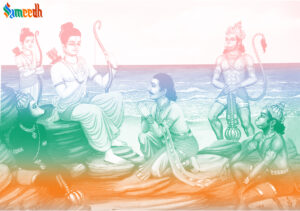Vibhishan is a significant character in the Hindu epic Ramayan. He is the younger brother of Ravan, the demon king of Lanka. Despite being born into a demon family, Vibhishan is portrayed as virtuous and righteous. His character stands out due to his unwavering devotion to Lord Ram, the protagonist of the Ramayan, and his adherence to dharma (righteousness).

Vibhishan is known for his righteousness, wisdom, and devotion to dharm (righteousness). Despite being a member of the demon (Asur) race and a part of Ravan’s kingdom of Lanka, Vibhishan becomes disillusioned by his brother’s tyrannical rule and unethical conduct. He disagrees with Ravan’s actions, particularly his abduction of Sita, the wife of Lord Ram, and advises him to return Sita and seek reconciliation with Lord Ram.
However, when Ravan refuses to heed his counsel and condemns him for his dissent, Vibhishan decides to defect and join Lord Ram’s side. He surrenders himself to Lord Ram, seeking refuge and pledging his loyalty to the rightful cause. Lord Ram, recognizing Vibhishan’s integrity and virtue, accepts him with honor and appoints him as the king of Lank after Ravan’s defeat.
Vibhishan’s decision to align himself with dharm and righteousness despite familial ties illustrates the importance of moral values and ethical conduct in Hindu mythology. He serves as an example of loyalty to truth and justice, even in the face of adversity. Vibhishan’s character is highly revered in Hindu tradition and is often regarded as a symbol of righteousness and integrity.
Vibhishan divulged the secrets of Ravan’s army and made sure Ram was victorious in the great battle. This information proved very vital to Lord Ram in this battle. He revealed the secret path to the temple of Nikumbala, the family deity of the Pulastya clan. When Meghnad (as per boon by Lord Brahma), mighty son of Ravan, was performing yagya in their family deity temple, to get a celestial chariot, mounting on which, he will win over any enemy in war and become invincible. But Brahma had also cautioned him that whosoever would destroy this yagna would also kill him. This yagya was destroyed under the leadership of Laxman, hence he would be the one to kill Meghnad. If this yagya would have completed, Meghnad would have become invincible on the celestial chariot.
During the final battle between Lord Ram and Ravan, when Ram was unable to kill Ravan, he revealed the secret of Ravan’s secret of invincibility to Ram. He told Ram that Ravan has stored the nectar of immortality in his belly and it is necessary to dry it. With this knowledge, Ram was finally able to kill Ravan.
When Lord Ram was to leave for Ayodhya after defeating Ravan, He assumed his true form of Vishnu in front of Vibhishan. He ordered Vibhishan to stay on earth and serve the people, and guide them to the path of truth and dharma. This made Vibhishan one of the seven Chiranjeevi, or immortal being.
Vibhishan’s status as a Chiranjeevi, or immortal being, stems from his significant role and exemplary qualities in the Hindu epic Ramayan. According to Hindu mythology, Vibhishan receives divine blessings or boons due to his virtuous character and devotion to dharm. These blessings are believed to grant him immortality or longevity, ensuring his eternal presence in the collective consciousness of devotees.
Key aspects of Vibhishan’s role in the Ramayan include:
- Defection from Ravan: Vibhishan recognizes Ravan’s unjust and immoral actions, particularly his abduction of Sita, the wife of Lord Ram. Despite being warned by Ravan, Vibhishana decides to defect from his brother’s side and ally himself with Rama, choosing righteousness over family loyalty.
- Advisor to Ram: After joining forces with Ram, Vibhishan serves as a trusted advisor and strategist. He provides valuable insights and counsel to Ram, aiding him in the battle against Ravan and the demon forces.
- Assistance in the War: Vibhishan’s defection proves crucial in the ultimate defeat of Ravan. He provides intelligence about Ravan’s strengths and weaknesses, which helps Ram formulate effective battle strategies. Vibhishan also plays a role in rallying support from other demon warriors to join Ram’s cause.
- Becoming King of Lanka: Following Ravan’s demise, Ram installs Vibhishan as the king of Lanka, rewarding his loyalty and righteousness. Vibhishan rules Lanka with fairness and justice, bringing prosperity to the kingdom under Ram’s benevolent rule.
- Symbol of Devotion and Dharm: Vibhishan’s character exemplifies the importance of devotion to dharm and righteous conduct. Despite familial ties and societal expectations, he chooses the path of righteousness, earning divine favor and respect.
Vibhishan’s character serves as a moral exemplar, illustrating the triumph of good over evil and the power of righteousness. His story resonates with devotees as a reminder of the importance of upholding dharma and making virtuous choices, even in the face of adversity.
Overall, Vibhishan’s story in the Ramayan highlights themes of loyalty, devotion, and the triumph of good over evil. He is revered as a noble figure who upholds dharm and stands as a symbol of righteousness in Hindu mythology.
